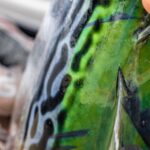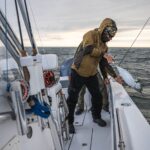
Albies Win in North Carolina: New Guardrail Management Rule Approved
After years of data pouring in from The Albie Project, advocacy, persistence, and support from
The Striped Bass Management Board will meet on August 1st to consider Draft Addendum II. There is a dizzying array of options contained in this draft. The result will most likely contain further restrictions if we hope to have a stock rebuilt to target by 2029.
These are the reductions we will face in the 2024 season:
“The recreational options presented herein are designed to achieve at least a 16.1% reduction in
the ocean and at least a 16.1% reduction in the Chesapeake Bay. All size limits are in total
length. Bag limits are per person per day. The Board will choose one option for each region.”
We have reviewed the documents and it largely echoes everything we heard in the PDT and SSC meetings that were held between May and now. The draft is just that: a draft. We have to wait until after the meeting to know what the final Addendum II will contain. You can expect the same diligent deep-dive and comprehensive resources from ASGA when the final document is available. With this full library of educational materials in hand, we will need all of you to heed the call after the meeting. That means attending virtual hearings, sending in comments and activating your fishing networks. We appreciate your trust more than you will ever know. If you think there are any additional resources we can provide to maximize our engagement and impact, don’t hesitate to reach out directly to us. We are here for you.
While we tread our way down this timeline, let’s talk about some serious concerns that ASGA currently has. For years, special interests have been given a get-out-of-jail-free card in relation to striped bass management and reductions. The “Striped Bass Friends and Family Program” through Conservation Equivalency (Don’t forget – CE SUCKS) has caused massive negative impacts on the fishery. We submitted this letter today so the Board knows where we stand.
First, the striped bass commercial fishery in the Chesapeake has not taken a reduction since 2015. Think about all the management actions since 2015. We are all supposed to be in this together. They are not doing their part. Under Hogan, Maryland DNR ran the Chesapeake for commercial interests leaving recreational fisheries to bear the entire burden of reductions. They took advantage at every twist and turn. Today, the commercial quota or striped bass in the Chesapeake is a little over 3 million pounds. The quota for the entire ocean is 2.4 million pounds. That’s 60% of the quota by weight. However, it is 80% of the quota by numbers of fish. Let that sink in.
To top it all off, we caught this announcement over social media:

“Lack of proper check-in station reporting.” That translates into people in the common pool for the hook-and-line fishery not bothering to check their fish in. Please tell us again how accountable you are…. This must be addressed. ASMFC cannot continue to allow this while we know there are no fish to catch here. If stripers were ducks, turkey, deer, salmon, or just about anything else, managers would address the obvious and substantially reduce the pressure on the Chesapeake due to poor recruitment. Look at Florida’s efforts to protect specific sites that have been scientifically identified as spawning grounds for critical reef and flats species. Spawning grounds matter.
The commercial striped bass sector in the bay has continued to harvest at rates that were questionable when we had a decent population of fish. Now, we have 4 terrible spawns in a row – and it looks like number five is on the way. We have been trying very hard to get any information from Maryland DNR regarding the current sampling for Young of the Year striped bass. It has been totally silent. Sometimes “no news is good news”. For a species that can use all the positivity it can get these days, this is likely very bad news. Combine the silence with the conditions over the winter and it is highly likely that we have another abysmal spawn on our hands. If that happens, all bets are off. We will know by the October meeting at ASMFC. This information could totally reshape Addendum II.
The other Friends and Family program is the carve-out for the charter fleet in Maryland. The fleet has been allowed to kill two fish per person if they use an electronic reporting system. This was another use of CE (still sucks) by Maryland to pick favorites. We were eager to see the impact of this ill-conceived mode split:

Maryland charters in the Chesapeake killed more striped bass than the rest of the Chesapeake and the entire coast combined. This is why mode splits, carve-outs, and Friends and Family packages are not acceptable. You are talking about 400-450 boats, mostly “part-timers” that killed 142,098 fish because Maryland put special interests in front of the resource.
The Chesapeake is hurting. Sure, things are changing – but they did this. We did this. We will never know what the Chesapeake is capable of until we ensure that Friends and Family packages are a thing of the past. The damage that was done can be repaired. The Chesapeake can come back if we curtail the pressure. That means no more carve-outs so a select few can harvest the remaining fish while the rest of us continue down a gradual road of progress.
The meeting next week needs to address these issues if there is any hope of keeping striped bass going in the right direction. The four (possibly five) bad year-classes are not enough to support the current level of harvest. We know what’s coming.
Enough is enough.
Fisheries management is a nuanced topic that deserves thoughtful conversation to achieve all stakeholders’ goals. Sometimes the best way to do so is by cutting through the political nonsense and saying what everyone is thinking: conservation equivalency sucks. The striped bass community made a resounding stand against CE during the Amendment 7 process. The number one issue in focus was putting guardrails on CE – over 98% of public comments fully supported this. Yet, CE is still alive and well.
Grab a set of stickers and let the world know conservation equivalency should be a thing of the past. You were thinking it, so we said it: CE sucks.
Feature Photo: Rex Messing of SIMMS Fishing

After years of data pouring in from The Albie Project, advocacy, persistence, and support from

This morning, the Connecticut Environment Committee held a hearing on House Bill 6248, a bill

Photo Credit: A striper released in Connecticut waters, courtesy of Mike Querfeld. Connecticut House Bill 6248 (2025

Feature Photo Credit: Rex Messing and the SIMMS team fishing with Captain Jaime Boyle Albie
We rely on our members and donations to keep fighting for a sustainable tomorrow in marine conservation.
GIVE THE GIFT OF FISHERIES CONSERVATION THIS HOLIDAY SEASON. SHOP ASGA GOODS THAT FUND FISHERIES RESEARCH & ADVOCACY CAMPAIGNS
JOIN ASGA IN CALLING FOR CRITICAL MANAGEMENT ACTION AFTER YEARS OF SPAWN FAILURES & POOR MANAGEMENT.
By using this website, you agree to our use of cookies. We use cookies to provide you with a great experience and to help our website run effectively. To learn more, please review our privacy policy.
5 Responses
Do you have a total number of fish reported for harvest for 2023 for recreational boaters. I saw the number for charter boats
The data for 2023 won’t be available for quite some time. Catch information for prior years is available to the public. https://www.fisheries.noaa.gov/data-tools/recreational-fisheries-statistics-queries
That 142,098 (reported) harvest number is a *monumental* under-reporting of the actual take. In 2022 there were 527 licensed for-hire charters operating in Maryland. An active boat runs 150-200 trips per year for striped bass. Even if only half the licensees (263) were active and ran (175) trips a year, there’d be 46,025 trips – with an average of 8+ anglers per trip, and given the charter limit is 2 fish/angler, that’s 736,400 (legal) fish assuming everyone limits out. At the reported rate, if all the MD for-hire fleet could catch in a year was 142,098 striped bass, they’d all be out of business because nobody was catching diddley-squat on a per-trip basis. That 142k number is totally specious.
That 142,000 number is waaaaay light..
They killed approx 25,000 from June 1 to mid july…we did some simple math..every single charter limited sometimes more than twice a day..
15-20 customers on board a whole bunch of times…terrible thing too watch
But catch and release is the problem…give me a break
Catch and Release mortality is down to 39% coastwide for 2022. In the Chesapeake, 2022 were the lowest catch and release mortality numbers ever recorded. So, we tend to agree and the science supports your statement